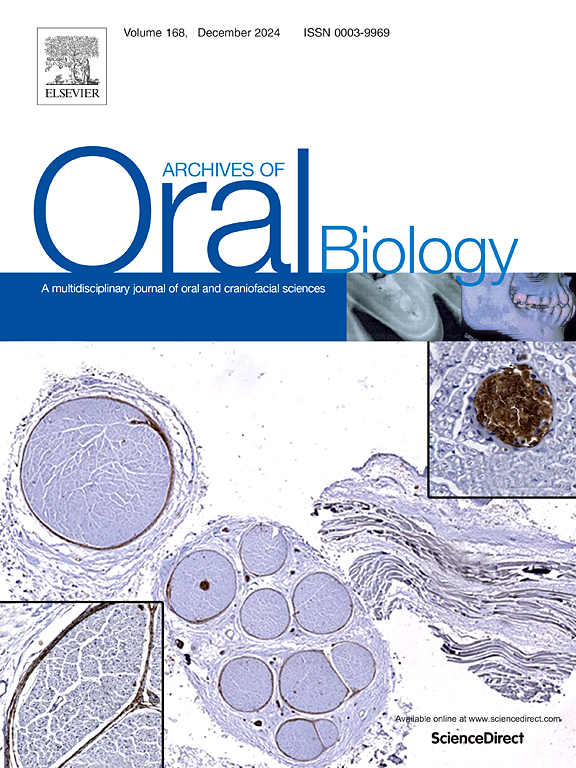Antibiofilm, regenerative and bone homeostasis potential of the synergistic association of synoeca-MP peptide with chlorhexidine in oral cavity opportunistic infections
IF 2.2
4区 医学
Q2 DENTISTRY, ORAL SURGERY & MEDICINE
引用次数: 0
Abstract
Objective
Synoeca-MP is an antimicrobial peptide that belongs to the class of defense peptides, known for their antimicrobial and immunomodulatory properties. To evaluate in vitro the association between synoeca-MP peptide and chlorhexidine, regarding their antimicrobial and antibiofilm activities, saliva stability, effect on tissue repair, bone resorption processes, and mineralized matrix formation.
Design
Initially, the minimum inhibitory concentration (MIC), minimum bactericidal concentration (MBC), and antibiofilm concentration were determined. The synergism and degradation of synoeca-MP and chlorhexidine in human saliva were assessed. Furthermore, biocompatibility was evaluated using MTT assays, hemolytic assays, and proliferation and migration assays of periodontal ligament cells. Finally, bone homeostasis was evaluated through osteoclastogenesis assays, alkaline phosphatase determination, and mineralized matrix formation assay with SaOs-2 and ligament cells.
Results
The antimicrobial and antibiofilm activity against the tested microorganisms was confirmed. Low synergistic concentrations of the synoeca-MP and chlorhexidine combination inhibited tested microorganisms. The association of these molecules remained stable in healthy saliva. Nevertheless, it degraded as the severity of periodontal disease increased. Additionally, lower synergistic concentrations of the combination were not cytotoxic to human cells, promoted the proliferation and migration of ligament cells, inhibited osteoclastogenesis, and increased mineral matrix formation of ligament cells and SaOs-2.
Conclusions
Synoeca-MP and chlorhexidine combination shows potential for oral diseases treatment, as evidenced by its antimicrobial activity, regenerative potential, saliva stability, and bone homeostasis. It may be particularly effective for opportunistic oral infections and in conjunction with mechanical therapy.
口腔机会性感染中滑膜- mp肽与氯己定协同作用的抗生素膜、再生和骨稳态潜力
目的:Synoeca-MP是一种抗菌肽,属于防御肽类,以其抗菌和免疫调节特性而闻名。在体外评估滑膜- mp肽和氯己定在抗菌和抗生物膜活性、唾液稳定性、对组织修复、骨吸收过程和矿化基质形成的影响方面的相关性。设计:首先测定最小抑菌浓度(MIC)、最小杀菌浓度(MBC)和抗菌膜浓度。研究了滑膜多糖和氯己定在人唾液中的协同作用和降解作用。此外,使用MTT试验、溶血试验和牙周韧带细胞增殖和迁移试验评估生物相容性。最后,通过破骨细胞生成试验、碱性磷酸酶测定和SaOs-2和韧带细胞矿化基质形成试验来评估骨稳态。结果:证实了其抗菌活性和抗菌膜活性。低协同浓度的synoeca-MP和氯己定联合抑制被试微生物。这些分子的结合在健康的唾液中保持稳定。然而,随着牙周病严重程度的增加,它会降低。此外,较低的协同浓度对人体细胞无细胞毒性,促进韧带细胞的增殖和迁移,抑制破骨细胞的发生,增加韧带细胞和SaOs-2矿物基质的形成。结论:Synoeca-MP与氯己定联合治疗口腔疾病具有抗菌活性、再生潜力、唾液稳定性和骨骼稳态。它可能对机会性口腔感染特别有效,并与机械治疗相结合。
本文章由计算机程序翻译,如有差异,请以英文原文为准。
求助全文
约1分钟内获得全文
求助全文
来源期刊

Archives of oral biology
医学-牙科与口腔外科
CiteScore
5.10
自引率
3.30%
发文量
177
审稿时长
26 days
期刊介绍:
Archives of Oral Biology is an international journal which aims to publish papers of the highest scientific quality in the oral and craniofacial sciences. The journal is particularly interested in research which advances knowledge in the mechanisms of craniofacial development and disease, including:
Cell and molecular biology
Molecular genetics
Immunology
Pathogenesis
Cellular microbiology
Embryology
Syndromology
Forensic dentistry
 求助内容:
求助内容: 应助结果提醒方式:
应助结果提醒方式:


